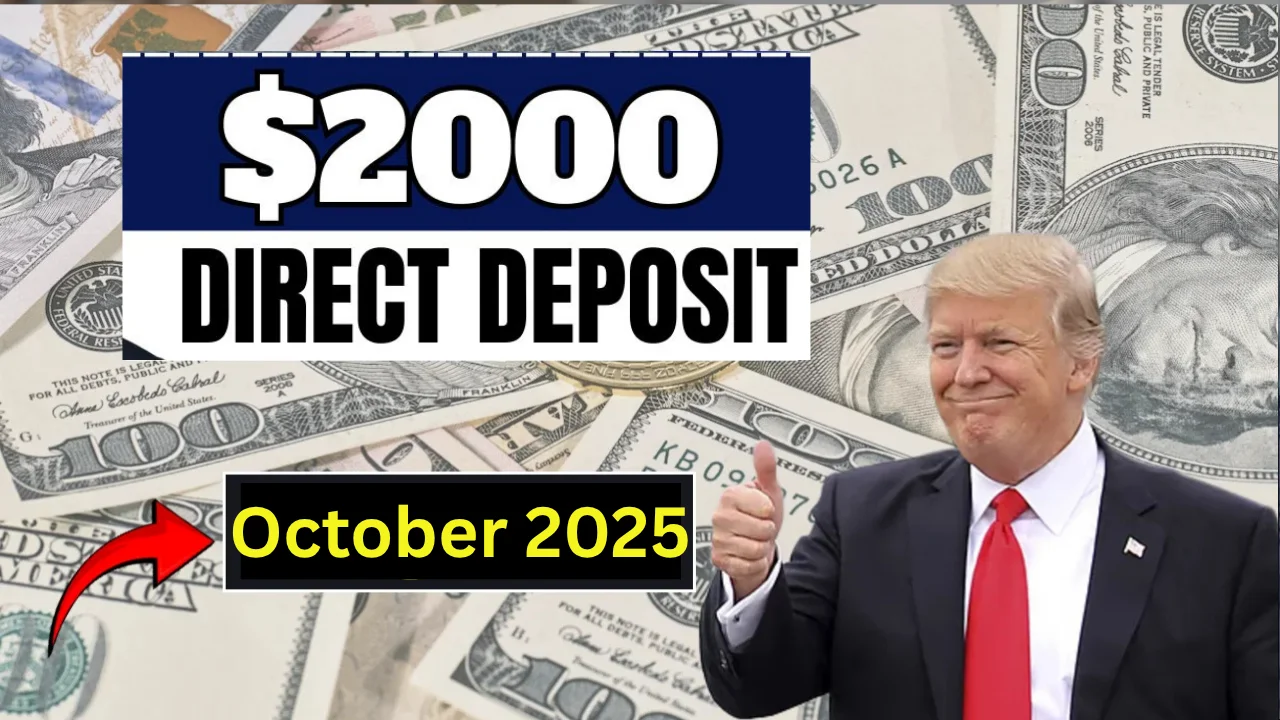Big News:Exciting news is sweeping the United States—a new direct deposit of $2,000 could soon arrive in the bank accounts of eligible Americans in October 2025. As families face rising living costs, this payment proposal aims to provide meaningful financial relief during the festive season and stimulate local economies.
The plan has been enthusiastically welcomed, especially by those struggling with inflation, rent increases, and everyday expenses. Here’s a complete breakdown of what the $2,000 direct deposit payment means, who is eligible, and how you can ensure you don’t miss out.
What is a $2,000 direct deposit payment?
The $2,000 direct deposit is part of a broader federal relief proposal designed to help working Americans and retirees cope with ongoing inflation and rising costs of living through 2025.
Unlike previous lump-sum payments during the pandemic, this program aims to provide targeted assistance to families most affected by economic pressures. Once officially approved, the IRS, in coordination with the U.S. Treasury Department, will oversee the disbursement process.
The move has been praised as a practical response to inflation fatigue, helping Americans meet essential costs like food, fuel, healthcare, and utilities.
Why October 2025?
The timing is no coincidence. The government reportedly scheduled the implementation of the plan in October 2025 to align with the fiscal year so that sufficient funds are available for distribution. Additionally, this timing will provide taxpayers and retirees with an opportunity to take advantage of this assistance before the holiday season – a time when household spending typically increases.
October also aligns with the Social Security COLA increase and adjustments to other federal assistance programs, making it a coordinated effort to strengthen financial stability for millions of citizens.
$4983 Social Security Benefit in October 2025 for Everyone: Check Eligibility & Payment Dates
Who Is Eligible for the $2,000 Direct Deposit?
Eligibility for the $2,000 direct deposit will largely depend on income levels, citizenship status, and tax filing history. Based on similar federal payment programs, here are the likely eligibility criteria:
-
U.S. Citizens or Legal Residents
-
You must hold a valid Social Security number or taxpayer identification number.
-
Permanent residents and green card holders are expected to qualify.
-
-
Income Thresholds
-
Single filers: Adjusted gross income (AGI) under $75,000.
-
Heads of household: AGI under $112,500.
-
Married couples filing jointly: AGI under $150,000.
Those earning above these limits may receive reduced payments, gradually phasing out for higher-income individuals.
-
-
Beneficiaries of Federal Programs
-
Individuals receiving Social Security (SS), SSI, SSDI, and VA benefits are expected to be included automatically, even if they don’t file taxes regularly.
-
-
Dependents
-
Families with dependents may receive an additional payment per qualifying child, similar to past stimulus rounds.
-
Expected Payment Dates
If approved on time, the first installment of $2,000 direct deposits is expected to be issued by mid-October 2025. To ensure timely delivery, the IRS will process payments in several phases:
- Phase 1 (mid-October): Direct deposits for individuals who filed their 2024 tax returns and have updated bank details on record.
- Phase 2 (late October to November): Paper checks and prepaid debit cards for those without direct deposit arrangements.
- Phase 3 (December 2025): Payments for special cases, including non-filers and individuals requiring verification.
Most recipients will see payments directly deposited into their bank accounts, marked “IRS Trace 310.”
IRS Instructions: How to Claim and Track Your Payment
The IRS will simplify and automate this process for most people, but there are a few important steps to ensure you don’t miss your payment:
- Update Your Tax Information
File your 2024 tax return before the deadline. The IRS uses this data to confirm eligibility and calculate the payment amount.
2. Set Up Direct Deposit
Payments will be faster for those who have direct deposit linked to their IRS account. If you’ve recently changed banks, make sure your information is updated on irs.gov.
3. Check Payment Status
Once payments are initiated, you can track your deposit using the “Get My Payment” tool on the IRS website or through your IRS online account.
4. Avoid Scams
The IRS will never call, email, or text you asking for payment or banking details. All official updates will only appear on irs.gov.
Why the $2,000 amount?
The $2,000 amount isn’t arbitrary—it’s calculated to reflect the average amount needed to offset recent inflation and help families manage rising expenses. Policymakers have stated that this number is based on inflation data, average household costs, and information from previous relief efforts.
For many, this isn’t just a matter of financial assistance—it’s a sign of the government’s acknowledgment that Americans are still facing financial hardship and need additional help.
$2,000 Direct Deposit From IRS in October? What You Need to Know
Public Reaction
News of the $2,000 direct deposit has received widespread support. Social media platforms are abuzz with Americans expressing relief and anticipation. For retirees and low-income families, this could mean the difference between meeting bills or falling behind again.
However, economists urge caution, noting that while stimulus payments boost short-term spending, they must be carefully managed to prevent inflation from rising again.
FAQs
1. Is the $2,000 direct deposit confirmed?
Not yet. It’s currently a proposed relief measure awaiting final approval from Congress. Updates will be announced on the official IRS website once confirmed.
2. Do I need to apply for the payment?
No. Payments will be automatically sent to eligible individuals based on 2024 tax filings and existing IRS data.
3. Will Social Security recipients get it automatically?
Yes. Those receiving Social Security, SSI, SSDI, or VA benefits are expected to get payments automatically via their existing deposit method.
4. How long will it take to receive the payment?
Most direct deposits should arrive within two weeks after the rollout begins, while paper checks could take up to a month.
5. What if I didn’t file taxes last year?
Non-filers can register or update their information through the IRS’s simplified filing portal when available.
Final Thoughts
The $2,000 direct deposit payment proposed for October 2025 offers hope to millions of Americans struggling with current inflation and financial uncertainty. While it still awaits final approval, the plan demonstrates that efforts to help citizens are not stalling.
If approved, this payment will not only provide additional cash but will also provide some relief, a chance to save time, and perhaps even a better start to the year ahead. Keep your IRS information updated and stay tuned for official announcements in the coming weeks.





